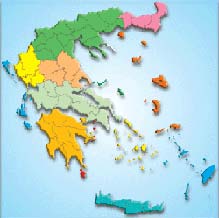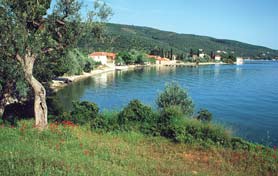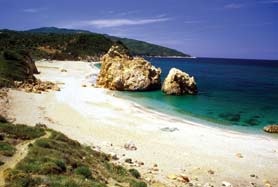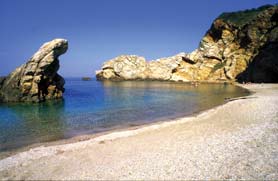
Please click on the map,
the region you want to visit |
|
|
|
|
| |
|
 |
Kalamos, Ksinovrisi, Paltsi, Metochi, Kallithea (Bir) |
|
 |
| Kalamos |
|
|
|
Leaving the road to the left that leads to Pau and along the scenic route through the olive groves, we reach the small and very picturesque coastal village of Kalamos.
It got its name either from the corruption of the word "kanalos" that is the channel formed by a small stream as it is joined to the sea, or from the many reeds (kalamia) that are growing in the riverbank.
Kalamos is one of the villages of Pelion, which still hold their traditional colour, developing mild tourism. Also, the visitors can enjoy the quiet beach of Belian, located near the village of Kalamos. |
|
Leaving Kallithea, three miles away, one can find, in the greenery of a knoll, the third municipal district of the City of Argalasti, Xinovrysi, which owes its name to the acidulous water that gushes outside the village, near to the sea. For the old name of Xinovrysis - Bistinika - there are many versions. Either it comes from the Slavic pestinikr and pesnik, which means "kiln" or from the name of a settler, or from the paraphrase of the sentence "mes t' stenika" from the place where the village is built.
In the region are identified several findings from the middle ages and in "Syrioti" area, there are still the few building remains of a medieval castle. Like the other settlements, Xinovrysi paid with blood its participation in the revival of the Revolution in 1823, as Xinovrysi was burned and its inhabitants either were killed or sold into slavery. |
|
 |
| Ksinovrisi, Potistika |
|
From the attractions of the village distinguishes the Church of Assumption, an aisled stone built basilica of 1778.
Of astonishing beauty and from one of the most famous beaches of Pelion, is the beach of Potistika from the side of the Aegean Sea. |
|
 |
| Paltsi |
|
|
|
Shortly before we arrived to Kallithea, turning right, we reach Paltsi in which are located two of the most beautiful beaches of South Pelion, on the side of the Aegean Sea, the St. Constantine and Melani.
In the area have been labelled residue of the early Christian times and other traces of the Middle Ages, near the Monastery of the Archangels (1776) a work by Stergios Basdekis.
The etymology of the name of the site is either from the Slovak balto (bog) or from the Turkish baici or balcilik that mean respectively "beekeeper" and "Beekeeping". |
|
This settlement with the many elements of the traditional architecture, is the second municipal district of the City of Argalasti.
The village was built during the period of the Turkish rule, maybe by monks of the monastery of Panagia (Virgin Mary), which is located outside the village and it belonged once as a major share of land to the monastery of St. Nicholas of Pau.
This is the most likely reason for the name of the village.
Below this location and just above Chorto, have been identified the ruins of a former settlement, which, according to local tradition, was burned by the Turks.
So, there is the probability that the first settlers of Metochi, may be were the residents of that vanished village. |
|
On the road to Xinovrysi, one encounters this quiet corner that retains its traditional "colour", as that is reflected particularly in some of the old houses from the years of the Ottoman rule. Then, the settlement was built there where the church of Agia Paraskevi is now and it was called Imirmpei, namely the village of "Imir Mpei".
| Municipality |
24230.54.219
24230.55.655 |
| Ksinovrisi |
24230.54.517 |
| Metochi |
24230.54.313 |
| Police |
24230.54.236 |
| Health Center |
24230.54.611-3 |
| Post Office |
24230.54.252 |
|
|
|
|
 |
Accommodation proposals, entertainment and shopping in Kalamos |
|
|
|